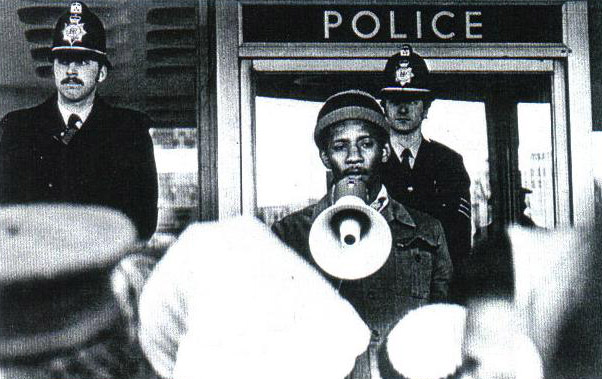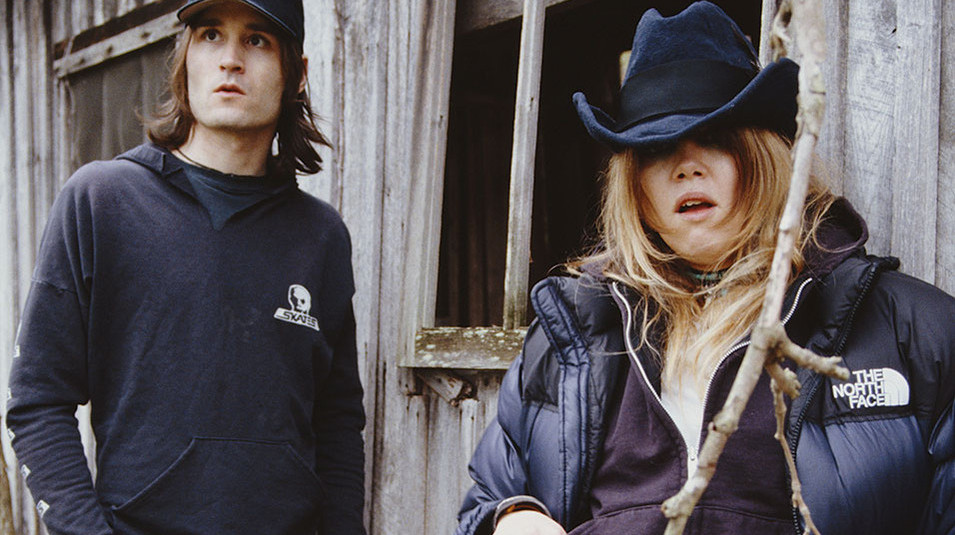Royal Trux’s “Trilogy” Trilogy
When the veterans of disorder were given a major label deal in the ‘90s, they set out to make three noisy albums that deconstructed the history rock & roll. Of course, things fell apart. Andy Beta reports
If Nevermind was the atomic bomb and the subsequent search for “the next Nirvana” the radioactive fallout, there was no stranger rock mutation in the 1990s than Royal Trux. Underground bands like Mudhoney, The Fluid, Paw and more inked multi-album deals with major labels in the mid-’90s, but fans and music biz insiders alike scratched their heads when it was announced that Neil Hagerty and Jennifer Herrema, notorious in the ’90s underground for their irascible noise tendencies and previously insatiable heroin habit, wound up on Virgin Records. Overnight, Lenny Kravitz and George Michael were Royal Trux’s labelmates, and there were rumors that Hagerty and Herrema had pulled off maybe the biggest post-Nevermind coup: a three album deal and a million dollar advance.
“I just wrote down everything that we could possibly want and our lawyer went: ‘This is Whitney Houston territory,” Herrema told me in 2010 when I interviewed her for the reissue of Thank You, Royal Trux’s major label debut. “But within a week he came back to us and said they had agreed to everything, except for a wardrobe allowance.” Kaz Utsunomiya, the man who had signed Nirvana to Virgin Publishing, believed in the dynamic between the harmolodics-heavy fretwork of Hagerty and the heroin chic moves of Herrema enough to sign Royal Trux to Virgin. It was a long way from the band’s beginnings.
Royal Trux self-released their untitled debut album in 1988 and by 1989, Dan Koretzky started up the Drag City label in Chicago primarily to release their inscrutable music. There were mysterious early seven inches, a VHS tape that rhetorically asked “What is Royal Trux?” and a murky double album, 1991’s Twin Infinitives, that decades later still defies all external logic, dense, harrowing and nightmarish, the closest sonic approximation of a bad trip or a heroin withdrawal.
But by their fourth album on Drag City, 1993’s Cats and Dogs, Royal Trux had hit a strangely psychedelic yet coherent groove. “We were oblivious to a lot of stuff but we realized that Cats and Dogs was selling well and we were getting big royalty checks and we were doing much bigger shows,” Jennifer remembered. When they pulled into Austin to play Emo’s around that time, the duo took the stage with a primitive drum machine mixed at twice the volume of Herrema’s vocals and Hagerty replaced his guitar with a screeching violin. “Neil wanted to do something different and that was his vision for the tour, [playing] with the violin,” Herrema said. For fans expecting to hear the band’s best material to date, it was obdurate and punishing, and it remains one of the biggest ‘fuck you’ shows I’ve ever seen. But that particular incarnation of Royal Trux was never recorded and a rumored live album for Matador Records never materialized. Less than six months later, Royal Trux returned as a full-bodied hard rock band on a major label.
“We saw the songs as fitting alongside hard rock and once it became a realistic proposition, we wanted to just do rock,” Herrema said of the ten songs that comprised Thank You. “There was such a closed connotation to ‘indie’ or ‘college’ music. It was supposed to be the alternative to the ‘evil’ major label rock, but in and of itself, it was just as sleazy, slimy and gross: we were fucked.”
Evoking a bygone classic rock era, Royal Trux put forth the notion that their major label albums would comprise a trilogy. As Hagerty penned on their now-defunct website:
The method with these records is to use transparented forms of commercial music to nullify context/assumption as regards content. The structure (as it is with ANY commercially available recorded music) is the cultural commercial avenue. This trilogy also progresses in a counter revisionist historical mode through the mythic 60’s-70's-80's (in the USA).
Said trilogy – 1995’s Thank You, 1997’s Sweet Sixteen and 1998’s Accelerator – was to correspond to a specific decade and the earmarks of said era. In a decade where grunge slid inevitably towards the lower common denominator of rage-filled rap-rock, Royal Trux didn’t have much of a shot at commercial success. “I liked to talk about that stuff sometimes too, though, because it seemed so pretentious and pissed people off,” Neil Hagerty told Perfect Sound Forever in 2015. “But all we were doing ever was trying to make rock records that kept the wheel rolling on. People said we were deconstructionists or something back in the ‘80s but it's really the other way, building a rock front up with little pieces of tin and chunks of cinder block.”
The band detested the idea of working with an outside producer, but Virgin pressured them and they wound up with crucial ally: David Briggs. Briggs’s production credits range from Spirit’s Twelve Dreams of Dr. Sardonicus and Alice Cooper’s Easy Action to enabling the darkness of Neil Young’s “Ditch trilogy” (comprised of Time Fades Away, On the Beach and Tonight’s the Night). Briggs hung out with the band and Royal Trux rehearsed for three months to get Thank You ready. And then, they rolled tape.
“It was recorded as a live album. I was mic'd up through a PA and we played on a stage,” Herrema told Perfect Sound Forever. “(David Briggs) didn't do anything physically; he didn't engineer and he didn't want to change us in any way, so basically he was there as a father figure or a cheerleader. I came to call him a ‘vibologist.’”
In a 1995 issue of the NME, Neil talked about Thank You “bridging the gap between the group and the masses we feel marginalized from…we wanna be outside and inside at the same time.” But it was too boogie rock for the college rock crowd and too conceptual for a rock crowd increasingly moshing towards rap-rock, and didn’t find much of an audience. Their biggest impact on pop culture might have been when Jennifer Herrema posed for Calvin Klein. Unfortunately for their label, Royal Trux didn’t have much interest in making music videos or going through the motions of promotion.
“There were a lot of things that bands on major labels would do that we weren’t interested in doing,” Herrema said. “And they couldn’t make us do them.” Their live show tightened up, though, with bassist Dan Brown and drummer Ken “Nasty” Nasta giving the group a solid foundation. It boded well for their follow-up, Sweet Sixteen.
The sessions were star-crossed almost from the beginning. As Herrema remembered it: “We bought a house [in rural Virginia] and David was going to do Sweet Sixteen with us as well. He flew out and stayed with us for a while and helped us build the studio and set-up bass traps. He didn’t know he was sick. He just had really bad back pain the whole time. And then his wife called me, freaking out when they found out it was lung cancer. And he was gone very shortly thereafter, less than a month. The night before we sent over steaks and Jack Daniels and then the next day, they upped his morphine drip and let him go.”
Due to personnel overhaul at the label, Briggs was the band’s lone bridge to Virgin and with his passing, Royal Trux soon cut off communications entirely, autonomous save for their business manager telling Virgin to keep cutting the checks. “We didn't talk to them at all during the whole production of Sweet Sixteen,” Herrema said. In some ways, it’s the most Royal Trux album imaginable, steeped in the moves of rock’s heyday, from the cowbell clops to the hairpin rhythmic turns that bring to mind Led Zeppelin’s Presence. Hagerty’s guitar is at its fiercest, grappling with horns on “10 Days 12 Nights” and with intergalactic noise on the title track. Every song expands beyond the four-minute mark, dense with lyrical references that only make sense in the Royal Trux universe.
Outside of their core fanbase, it would have been impossible for Trux initiates at the record store to make it past Sweet Sixteen’s infamous cover art. Depicting a (purportedly staged) toilet clogged with blood, feces and toilet paper – topped with the band’s initials in pastel cake frosting atop the glop – it would make even the crustiest CBGB’s denizen gag upon sight. Sweet Sixteen did even worse than its predecessor, garnering a one-star review in Rolling Stone (calling it “regurgitated sonic swill”), with sales in the proverbial toilet.
Trux’s third part of the trilogy wound up back on their original home, with Drag City releasing Accelerator in 1998. A messy yet exhilarating listen, the band cut off the low end and pushed everything into the red. Oddly, it’s their most hook-filled album since Cats & Dogs and was treated as a return to form by the music press. “Accelerator was tightly compressed, but it was more pop,” Herrema said. “These were just things we came up with in our head that represented those decades to us.” Two more albums followed before the band broke up in the early ’00s. But with Hagerty and Herrema touring again, who knows what music might lie ahead?
Ultimately, Royal Trux’s rock trilogy aligns with the likes of Sergio Leone’s “Dollars Trilogy” or Neil Young’s “Ditch Trilogy,” in that they actually aren’t trilogies (in the Lord of the Rings sense). “By no means are those records tributes to specific decades,” Herrema explained to PSF in 1999. “If you hear the records you immediately know they're not tribute albums. It was fun to take the production techniques of that time and the equipment we chose, and the instrumentation we used. But it was not trying to recreate something in a new way.” Whether you hear Thank You, Sweet Sixteen and Accelerator as homages, deconstructions or sly tributes, Royal Trux broke apart rock music at the end of the 20th century and put it back together in their own inimitable way.

